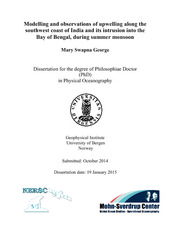| dc.contributor.author | George, Mary Swapna | eng |
| dc.date.accessioned | 2015-04-09T09:39:23Z | |
| dc.date.available | 2015-04-09T09:39:23Z | |
| dc.date.issued | 2015-01-19 | eng |
| dc.identifier.isbn | 978-82-308-2732-1 | en_US |
| dc.identifier.uri | https://hdl.handle.net/1956/9731 | |
| dc.description.abstract | Coastal upwelling regions are among world´s most productive areas, with high levels of primary productivity and fishery potentials. The southwest coast of India is a classic example of such an upwelling system during the boreal summer monsoon. By using a numerical model based on the Hybrid Coordinate Ocean Model (HYCOM) and observational data sets, this upwelling along the southwest coast of India and the associated Cold Pool that forms during summer monsoon are examined in detail. In the first paper, the model was validated for the north Indian Ocean using available in situ and satellite observations. The model simulation of the circulation patterns of the north Indian Ocean matched well with the observations. The surface and subsurface features were also simulated well by the model. Therefore it was concluded that it could be further used as a tool to study the upwelling system and its associated characteristics. Paper 2 analyses the interannual variability of upwelling along the southwest coast of India during a period of ten years from 2001 to 2010. The strong monsoon winds over the Indian Ocean have an impact on the circulation of the region. The alongshore component of the wind along the southwest coast of India strengthens during the summer monsoon. The influence this alongshore wind stress has on the upwelling along the coast is examined and found to be having a moderate correlation with the observed cooling. The study also implied the importance of remote forcing on determining the variability of upwelling in the region. The Summer Monsoon Current (SMC) carries a part of upwelled cold waters that form along the southwest coast and the locally upwelled waters from the southern tip of India into the Bay of Bengal. The final paper addresses this Cold Pool intrusion into the Bay of Bengal. During the break phases of Indian summer monsoon, the surface winds shifts southward and becomes stronger south of India and Sri Lanka. We examine a new hypothesis that enhanced open ocean upwelling occur in the Cold Pool region during these break phases, owing to the wind pattern and the study confirmed that this hypothesis is true. The analyses from the papers also proved the potential of HYCOM model to be developed into a forecasting tool for the study region. | en_US |
| dc.language.iso | eng | eng |
| dc.publisher | The University of Bergen | en_US |
| dc.relation.haspart | Paper I: George, M. S., L. Bertino, O. M. Johannessen and A. Samuelsen (2010), Validation of a hybrid coordinate ocean model for the Indian Ocean. Journal of Operational Oceanography, 3(2), 25-38. Full text not available in BORA due to publisher restrictions. The article is available at: <a href="http://goo.gl/OhEHuV" target="blank">http://www.tandfonline.com/doi/abs/10.1080/1755876X.2010.11020115?tab=permissions#.VSZJ9Y6Ud8H</a>. | en_US |
| dc.relation.haspart | Paper II: George, M. S., L. Bertino, A. Samuelsen, K. A. Joseph and O. M. Johannessen, Upwelling along the southwest coast of India during summer monsoon: Observations and Modelling. Full text not available in BORA. | en_US |
| dc.relation.haspart | Paper III: George, M. S., P. V. Joseph, K. A. Joseph, L. Bertino and O. M. Johannessen, Modelling and observational study of the intrusion of Cold Pool into the Bay of Bengal in association with the summer monsoon. Full text not available in BORA. | en_US |
| dc.title | Modelling and observations of upwelling along the southwest coast of India and its intrusion into the Bay of Bengal, during summer monsoon | en_US |
| dc.type | Doctoral thesis | |
| dc.rights.holder | Copyright the author. All rights reserved | en_US |
| dc.identifier.cristin | 1196615 | |
